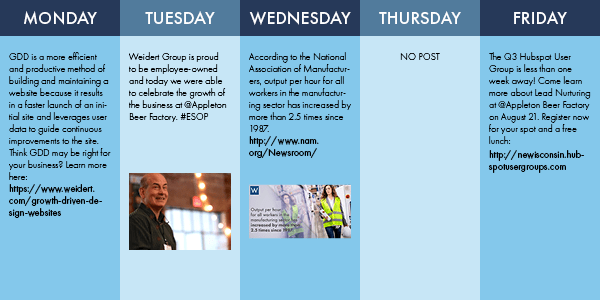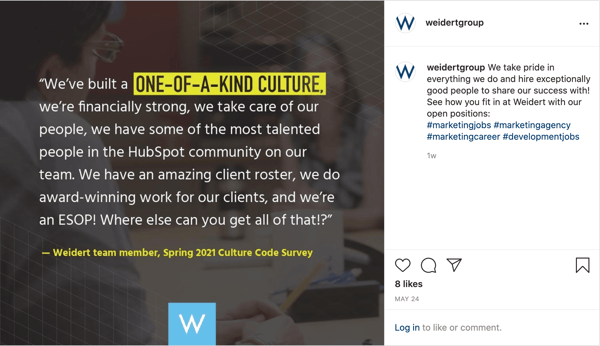Showcase Your Company Culture on Social Media With Our Top 5 Tips
Written by
Social media is an essential inbound recruiting tool for showing and telling potential applicants about your company culture, but successful recruiting and retention requires more than just promoting company culture on social media posts.
2020 and the COVID-19 pandemic accelerated technology adoption — and a pre-pandemic Glassdoor study already reported 79% of job seekers using social media in their search.
Business cultures and coworker relationships have also been evolving online, as companies learn to navigate the shifting landscape of remote and in-office work, and social media platforms help provide some of the structure and sense of “place” that the office used to serve.
According to Harvard Business Review, 82% of employees think social media can improve their professional relationships, and employees who use social media to connect with coworkers tend to be more motivated and have more innovative ideas.
So it’s important not only to promote company culture on social media but also to actually nurture and grow that culture in the first place. And as employers compete for talent in a professional landscape that’s been blown off the map by remote work, promoting company culture on social media can help you attract prospective employees who like what they see — which could help you find a better fit, faster.
How can you highlight employee and workplace culture on social media?
1. Define and articulate your company culture
“We have a great company culture.”
“Our people are the best.”
Sound familiar? True as it may be, when asked to define their culture, many companies are hard-pressed to identify what makes theirs special.
Before you communicate your culture to the world, you need to define it in tangible and intangible ways. At Weidert Group, our culture code is an articulated set of principles that we return to again and again, as individuals and as a team, to assess how well we measure up to our promises.
Informal interviews with employees can be a great place to start. If you truly have a great culture, people will want to talk about why they love coming to work every day. When you hear first-hand about employees’ positive feelings toward your company and their coworkers, you’ll get a sense of what sets your culture apart.
Consider setting up short meetings or soliciting survey input using open-ended questions. Some may include:
- What makes you proud to work here?
- In what ways do you see our company celebrating success?
- How do team members fix problems or mistakes?
- What’s your favorite part of the workday or week?
- How do you think the company is viewed by the community? By our competitors?
- How does the company support your personal and professional growth?
- Would you recommend our company to a friend? Why or why not?
These questions are just a starting point. The answers, all together, should illustrate your culture in action. The result — your company culture, defined — can set the stage for articulating and promoting it, so it’s easy for potential recruits, as well as customers, to find and see for themselves.
That means developing the language of your culture based on your day-to-day vocabulary and incorporating elements of style into the words and images that express the big ideas behind your success.
Capturing your culture in words and images gives you the raw material to build and create social media content that accurately expresses who you are, what you value, and why.
2. Choose the right social media platforms
Each social media platform has its own generational appeal, tone and aesthetic, and user tools that make it the right choice for some, but not all, businesses. You’ll need to adjust your social media messaging with platforms and target audiences in mind. Don’t plan on simply copying and pasting across all your social media sites.
If one of your goals of promoting company culture on social media is to attract talent, you may consider moving beyond the big three — LinkedIn, Facebook, and Twitter. These are the primary go-to platforms for attracting professional recruits — with LinkedIn boasting 3 people hired per minute on its site. Other spaces, such as Instagram, might be useful for attracting younger audiences. But wherever you decide to create company profiles and post, do it thoughtfully and intentionally.
Pro tip: Whichever platforms you choose, stay current. Social media sites evolve at a relatively rapid pace, and that means changing tools and features, algorithms, even user statistics. If you need more information to help determine which sites to choose, we’ve got 37 statistics about B2B use of social media that can help you get a better picture of what’s out there.
3. Create a social media plan
A social media presence requires at least a little spontaneity and room to respond to news, and posting about fun, unexpected events at work help illustrate a thriving culture and work atmosphere.
But just as you plan your blog schedule and emails as part of your inbound marketing plan, you’ll want to plan at least some of your social media content ahead of time. Having a plan ensures consistent posting, and can help you create a wider variety of posts that really shine a spotlight on your whole team culture.
When creating your social media posting plan, follow these general guidelines:
- Start consistent and stay consistent. Plan to post a few times a week on each platform. Quality posts get favorable attention over quantity, so posting daily isn’t worth it if you aren’t creating solid content for your posts. A little extra time creating useful content can increase engagement, and those likes and shares increase your visibility. This is especially important for businesses, since some social media channels algorithms don’t necessarily favor company pages — they’d rather you pay for visibility.
- Plan in advance. Scheduling posts helps keep your social media work manageable. Social scheduling tools like HubSpot or Hootsuite can make it a lot easier, and their analytics features can help you get a clearer picture of engagement across channels.
- Create a schedule. You can use theme and content ideas to structure your posting schedules, to balance between more business-focused content and company culture highlights. Why not have a “Motivational Monday,” a “Fun Friday,” or another designated recurring themed day? You can feature a theme or topic during a specific month or choose a specific day of the week for your culture posts.
No matter what content you feature, stay engaged with your buyer personas, potential recruits, and the local community by creating a schedule. Below is an example of what that might look like, but keep in mind that you don’t necessarily need to post every day.

- Repurpose posts. Once you’ve captured content, don’t just create a post for a single platform. Get more mileage by making appropriate adjustments for word count, tone, images, and more, and use the concepts and content across multiple platforms. This enables you to develop a presence and strengthen your identity across channels without spending too much time finding and sorting content. Use the extra time to make sure the posts are well-suited to the different social media environments.
- Post at the best possible times. Do LinkedIn users view content at the same time of day as Facebook users? No. Did you know that Wednesday is the best day to post on Twitter? It’s true. Vary your posting times based on when your ideal target audience is most likely to see your content. This infographic offers a quick reference with recommendations for the major social media sites, and HubSpot offers research-based data on ideal LinkedIn posting times by industry.
Pro tip: Don’t stray too far in differentiating posts across channels. Whatever platforms you choose, your company biography and identity should stay consistent. Include your summarized mission statement, and use your current logo in your profile image. Write thoughtful descriptions for your bio and boards because those tags contribute to your SEO.
RELATED: CHECK OUT OUR COMPLETE GUIDE TO SOCIAL MEDIA FOR COMPLEX INDUSTRIES
4. Use a range of content and media types
Build from a mix of content sources. Culture posts usually come from inside your own organization, but links to published work can also support your messaging. Sharing posts from companies that share affinities with yours can also help demonstrate your culture.
Balance quirky and fun with deeper, more serious content. Your employees have terrific personalities; maybe they’re also authorities on subjects within your industry. Introducing staff on social media creates opportunities to reflect both of these truths. Industry-subject memes or infographics, employee quotes, and your company's perspective on important subjects all reflect your culture.
Photos draw interest and support messaging. You can get a lot across with a good image. You can also grab attention to increase engagement and visibility for the text content of your posts. Pay attention to character counts, and keep it succinct.
Got a GIF library? Creating short, lively GIFs can help you build fun visual themes you can use for recurrent messages that recognize employees for accomplishments, promotions, milestones, and more. They can also bring a lightness and humor to holiday-themed posts.
Use video. I’d be remiss if I didn’t extol the effectiveness of video in recruiting efforts and communicating your culture. While the written word can tell someone about your culture, video can show and tell it. Video is the perfect tool for capturing the subtle nuances, body language, and interactions between your employees that show how they respect and enjoy collaborating.
5. Build variety into your content
One great thing about social media is that it allows you to show different sides of your organization, and even engage in conversations and content that might feel out of place on your website or in emails. Here are a few ideas for how to highlight employees on social media and level up your social presence:
Choose a theme or topic. Consider interesting statistics about your industry, or employee initiatives you’d like to spotlight. Maybe your organization supports specific local nonprofits or a community event. These are great opportunities to share and show what kind of people work at your organization.
Discover your greatest hits, and share the love for them beyond your employee teams. For example, among Weidert Group’s employee clubs, with remote employees meeting virtually throughout the work-from-home period, is the popular Beer:30 Club.

Our work is certainly not all fun and games, but we do enjoy each other’s company — and occasionally showing the fun side of your organization and industry can be inviting to potential recruits and customers. Brand your content related to the topics you choose, and build structure into your social posting strategies.
Mix it up. Show the many ways employees engage: company parties, happy hours, team building events, volunteering, Halloween costumes, collaborating on the plant floor, working together on a product launch, or other important company events. Include insider testimonials when appropriate, and ask employees for their company culture ideas. You can’t fake a strong culture, so create content that tells it like it is.
Encourage employees to post, like, and share. When your employees engage in your social media content sharing, it not only helps spread your message far and wide; employee advocacy also lends even greater credibility and authenticity to your content.
How and what you choose to highlight about your company culture varies with every company. An industrial manufacturer might not share the same content, aesthetic, or tone as a marketing agency.
But these five major guidelines can create a shortcut to identifying and communicating what your culture is like, choosing how and where you want to showcase it online, and putting a plan in place to promote it effectively. Altogether, this is a good universal start for any company looking to maximize its inbound recruiting efforts.
Attracting the right people and talent has always been challenging; changes in technology and the competitive landscape have added complexity to recruiting. Just as inbound marketing can be a great fit for products and services in complex industries and markets, strategic use of inbound principles can deliver meaningful results to your recruiting process.
Our guide, Inbound Recruiting Essentials for Industrial Sectors, can help you use inbound content to more effectively attract new hires, turn your culture into an attraction and engagement force, and show prospective employees what’s great about your company. Just click the link below to get started.
Subscribe To Our Blog
Information. Insights. Ideas. Get notified every time a new Weidert Group blog article is published – subscribe now!
You May Also Like...

Search Engine Optimization
Optimize Your Industrial Website for AI Search

Marketing Technology
Why Unified Data Efforts Fail (and How Manufacturers Can Fix It)

Search Engine Optimization
How Falcon Rebuilt Industrial AI Search Visibility in 2025
Accelerate Your Growth with
Weidert Group
If you’re ready to explore a partnership, request a personalized consultation with our team.




